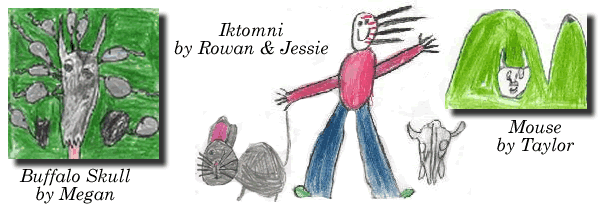|
|
Stoney Discoveries
: Stoney Stories : Iktomi
and the Mouse Dance

Our summary of Iktomni and the Mouse Dance told by;
Megan, Rowan, Jessie & Taylor
It is the changing moon when
buffalo grow new robes. Iktomni is walking along the Coyote Foothills.
He hears the sound of many voices coming from a buffalo skull. He walks
over and looks into the skull and sees mice singing and dancing. He shrinks
his head so he can join them and puts his head in the eye hole of the
buffalo skull and sings. He gets so tired that he falls asleep. When the
magic wears off and his head gets bigger and he is trapped inside the
buffalo skull. The Sun wakes Iktomni and he still has the buffalo skull
on his head. He looks for a rock and hits his head on a big rock. The
skull won't come off. He heard some birds flying his way and he told them
if they helped him break the skull he would give them his first born daughter.
They help him break the skull, but Iktomni had lied to the birds. He did
not have a daughter. He breaks his promise and he puts a curse on the
birds and that is why they fly in circles and not straight.
What did we hear in this story that we have heard in other stories?
- We keep on seeing the number
4. In this story Iktomni looked in the 4 directions. The birds strike
the buffalo skull and on the 4th hit they break the skull. Perhaps it
is a sacred or a special number?
- Iktomni is a character in
the Stoney stories who is often annoying. He sometimes did terrible
things. He was a liar and he cursed the birds.
- We keep on seeing the buffalo
and the eagle. They must have been special or sacred to the Stoney.
Why was this story told? We think...
- The story was told to explain
why birds always fly in circles because the children were wondering
why.
- The story was told so that
it could be passed on to other children so that everyone would know.
- It is important to think
before you make a promise so that you can always keep your promise and
you don't have to change your mind.
|

